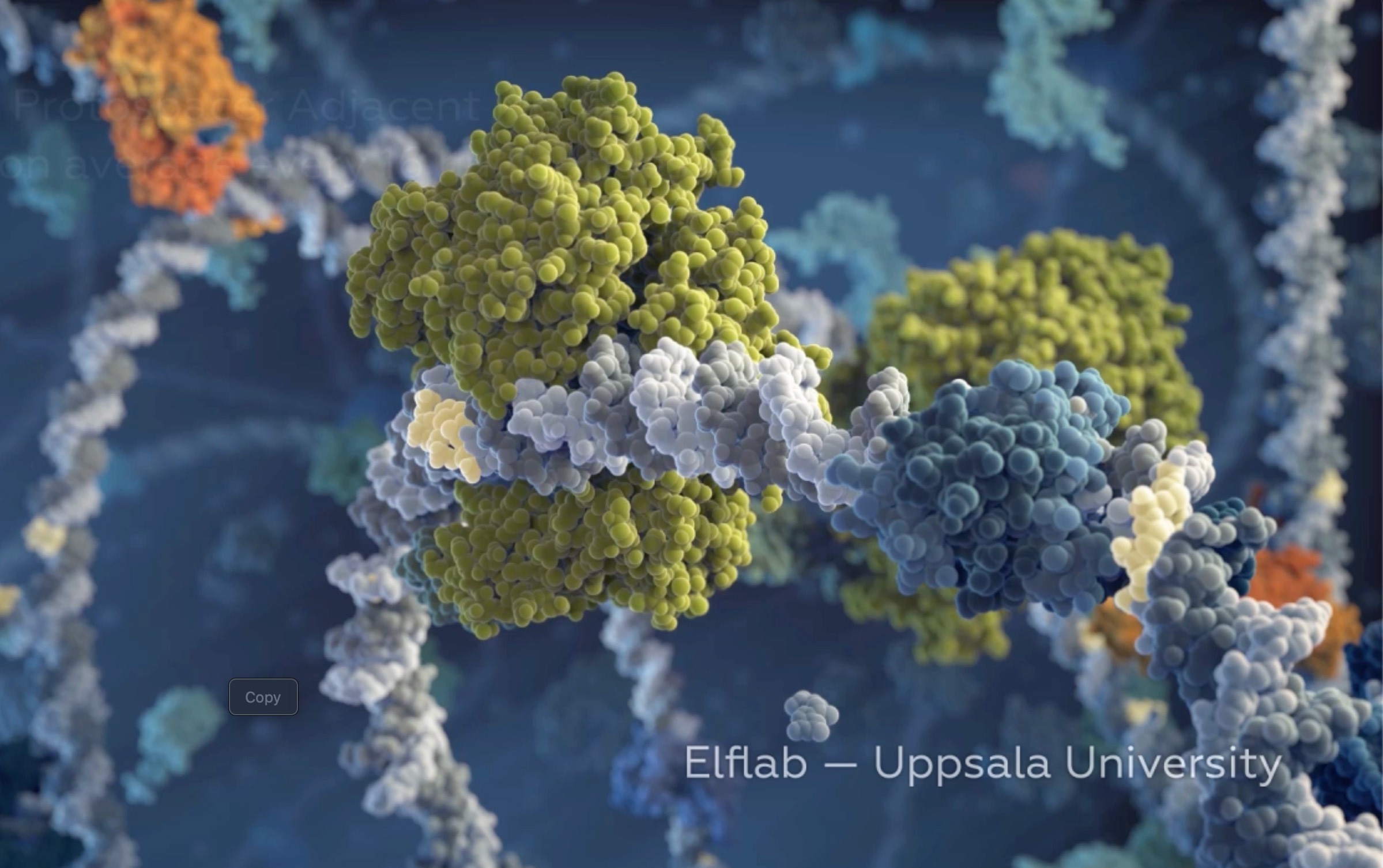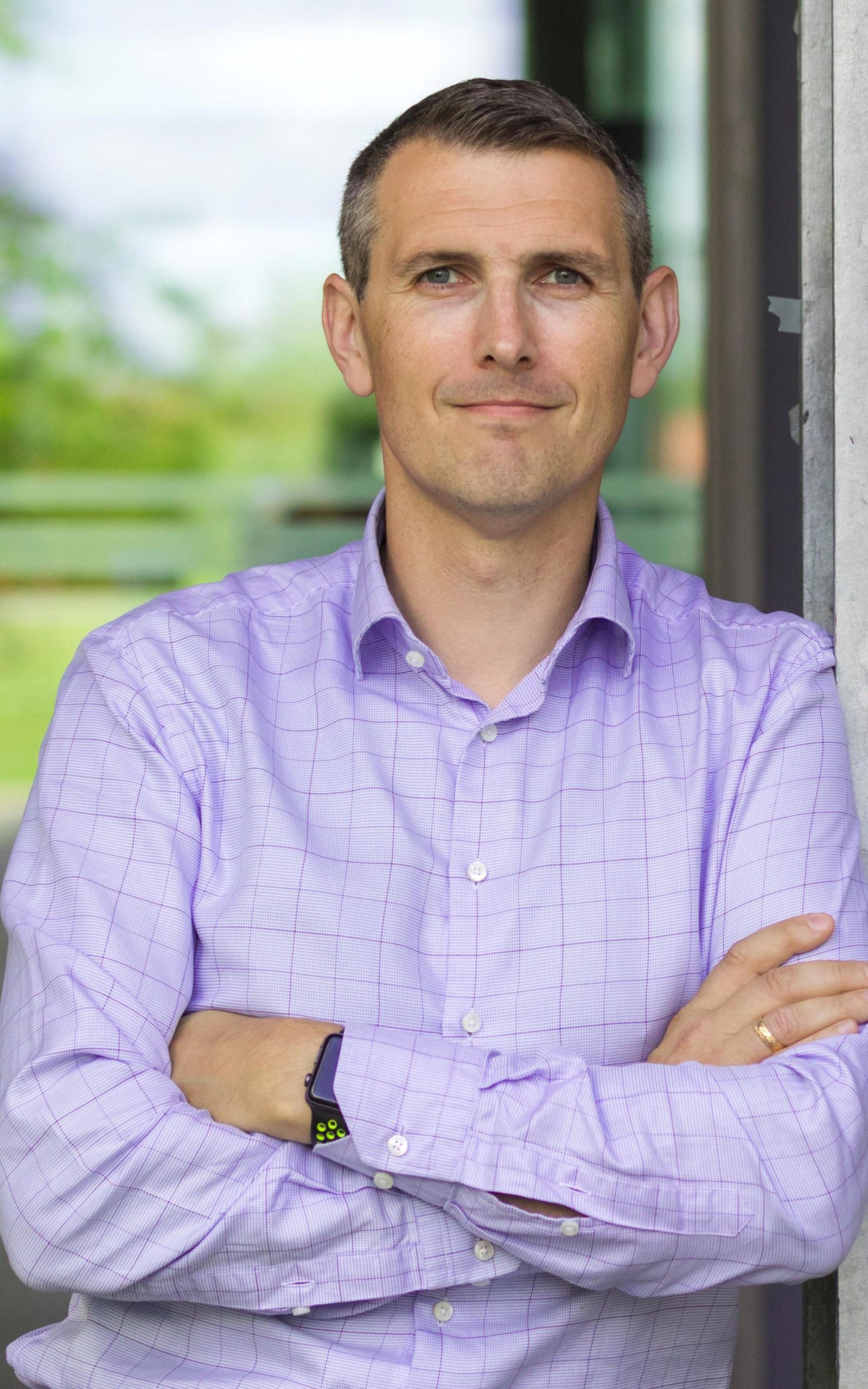Johan Elf
We work across the boundaries of the traditional scientific disciplines to address fundamental and challenging biological questions related to gene expression, chromosome structure, and the bacterial cell cycle. In particular, we strive to test quantitative predictions and to identify inconsistencies in current biological models. This agenda has made it necessary to sharpen the experimental tools both in terms of throughput, sensitivity, and spatiotemporal resolution. A few areas where we have explored how the biological cell has solved physical challenges are outlined in the following sections.
The search problem
How do molecules search for and identify specific genetic information in the genome? This question has been the theme for several different projects in the lab. We have concluded that the transcription factor (TF) lacI, which acts as a repressor of the lactose digestion machinery in the cell, searches for its binding site using a combination of 3D diffusion and 1D sliding on the chromosomal DNA. The TF slides around 45 bases before detaching after 1 ms and although it searches the entire genome, it takes only a few minutes for the protein to find and bind the operator.

In ongoing work on LacI, we are measuring how the TF interrogates DNA at the microsecond time scale. In contrast to LacI that searches the DNA sequence through interactions with the DNA grooves, Cas9 needs to unwind the double helix and interrogate the DNA sequence to discriminate right from wrong. Although Cas9’s search problem is somewhat reduced by the fact the potential targets are defined by the presence of a PAM sequence, it still presents a daunting task. We could measure that it takes on average 6 hours for a dCas9 molecule to find its target sequence. Compared to the search time of the transcription factors it’s an eternity, but it is the price that the CRISPR/Cas9 system has to pay to be reprogrammable to target any sequence.
We have also contributed to answering the long-standing question of how a broken chromosome can search for and find its homologous sister in a matter of minutes following a double-stranded DNA break. By incorporating the broken strands into a stiff, transcellular filament, the cell reduces the search problem from 3D to 2D which considerably speeds up the process.
Noise in gene expression
We have demonstrated how the binding strength of transcription factors affects noise in gene expression. Following a biological cue, it can take several minutes before a TF finds and binds its target sequence. As a result, negative feedback (where the expression of a TF is inhibited by the TF itself) cannot at the same time be fast and strong. If the TF binds strongly to the repressor site, most proteins are necessarily produced in a burst immediately after gene replication and if the binding is very weak, is practically unregulated. To this end, we predict the existence of an optimal TF binding strength, where the time the binding site is free is not dependent on TF concentration. To produce biological evidence of this optimum is an ongoing effort.
Cell cycle control
As a result of our investigations of the coordination of replication and cell division, we have found that genetically identical bacterial cells display a large variability in sizes and generation times also in a constant environment. Given this variation, it is not obvious how the cells manage to coordinate DNA replication and cell division, to ensure that there are always two chromosome copies ready for each division. The problem is especially hard considering that rapidly growing bacteria have multiple replications of the same chromosome ongoing at the same time. Currently, we are investigating the mechanistic details of how the cell can coordinate its replication and division events.
The 4D chromosome
The importance of the chromosome sequence is established and well studied, but the significance of the 3D structure and its contingent correlation with the cell cycle is not known and far less studied. Our ambition is to create a time-resolved high-resolution E. coli chromosome structure that would allow us to ask questions related to the structure and function of the chromosome reaching beyond the information encoded in the local DNA sequence. Scientific questions that we want to answer based on this structure are for example (1) how reproducible is chromosome organization from cell-to-cell at each point in the cell cycle, (2) does the 4D position of a segment depend on its sequence or its 1D position in the chromosome, (3) how does the structure change in response to large sequence rearrangements, (4) how does the 3D localization of a gene influence its expression, (5) how does the cell manage the different chromosome copy numbers at different growth rates and (6) how is the structure altered to allow homologous recombination after a specific double-stranded break?
Antibiotic resistance development and how to prevent it
When developing methods to study the replication-division control in bacteria, we accidentally stumbled on a tool that made it possible to very rapidly determine antibiotic susceptibility in relatively dilute bacterial samples. This embarked us on a journey to not only understand the development of antibiotic resistance in molecular detail but also to find ways of mitigating this development. Our goal is to reduce the morbidity and mortality in human and animal infections, reducing antibiotic use and resistance development, extending antibiotic life, and achieving better clinical trials of new, cheaper antibiotics.
By capturing bacteria directly from patient blood in a microfluidic chamber and measuring the growth of individual cells optically, we can obtain a measure of antibiotic sensitivity. If combined with AI species identification, this method can be used also to diagnose complex infections with multiple pathogens present. For sepsis patients, every minute counts, and for this method to be clinically relevant, the time from the sampling of patient blood to response should be no more than a few hours.
Tuberculosis diagnostics
Drug-resistant tuberculosis (TB) is a major threat to human health and a contributor to antimicrobial resistance worldwide. The bacteria that cause TB a slow growing, and testing the bacteria’s sensitivity to different antibiotics is incredibly time-consuming. Using a microfluidic solution to trap bacteria and monitor the drug response on the single-cell level in real time, we aim to develop a new antibiotic sensitivity test for TB that can shorten processes from several weeks to less than 24 hours.
New technologies
Many of our biological questions have driven technological innovation. The development of customized microfluidics for single-molecule experiments in living bacterial cells has been essential for the transcription factor and cell cycle work (Hammar et al., Science 2012; Hammar et al., Nat. Gen. 2014, Jones et al., Science 2017, Wallden et al. Cell 2016).
New approaches to using single-molecule tracking have been critical to determining intracellular kinetics rates (English et al., PNAS 2011; Sanamrad et al. PNAS 2014; Balzarotti et al. Science 2017, Volkov et al., Nat. Chem. Biol. 2018) and these studies have also involved important improvements in the analysis and software (Persson et al., Nat. Meth. 2012; Lindén et al., Bioinformatics 2016).
To bridge the current gap between advanced imaging and high-throughput genetic engineering, we have developed DuMPLING (Lawson et al., Mol. Syst. Biol. 2017, Camsund et al. 2019). This optical technology can be used to phenotype a large strain library and subsequently identify the genetic identity of the strains by in situ genotyping. Combined with visionary cloning strategies, this method promise to deliver new insights on previously inaccessible scientific problems. We also aim to further increase the resolution with which it is possible to investigate biological systems in living cells. The Poltrack system (Marklund et al. Nature 2020) is an extension of the MINFLUX microscopy (Balzarotti et al. Science 2016) that uses ultrafast hardware-based feedback laser scanning and nanosecond time tagging of individual photons to determine the absolute orientation of the fluorophore dipole moment in the sub-millisecond time regime. This technique closes an important gap in studying dynamic systems in the life sciences.
In our work with different aspects of antibiotic resistance, we have contributed a rapid resistance determination test for clinical samples (Baltekin et al., PNAS 2017).
Group Members
Irmeli Barkefors, Secretary, Project Coordinator
David Fange, Senior Research Scientist
Spartak Zikrin, Scientific programmer
Jimmy Larsson, Senior Scientist
Elias Amselem, Senior Research Scientist
Johan Öhman, Research Engineer
Beer Sen, Research Engineer
Malin Lüking, Researcher
Daniel Jones, Senior Researcher
Vinodh Kandavalli, Senior Researcher
Dvir Schirman, Postdoctoral Fellow
Buu Minh Tran, Postdoctoral Fellow
Irfan Ahmad, Postdoctoral Fellow
Ozden Baltekin, PhD student – On leave
Oscar Broström, PhD student
Konrad Gras, PhD student
Praneeth Karempudi, PhD student
Jinwen Yuan, PhD student
